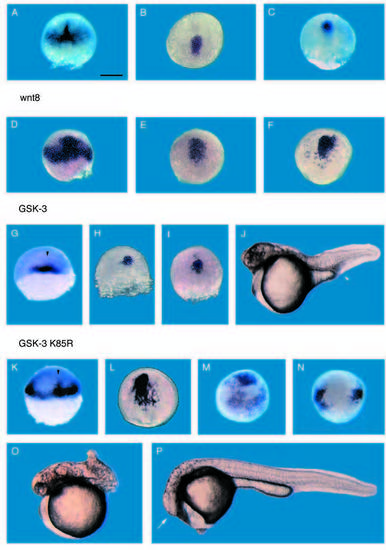Fig. 6
- ID
- ZDB-FIG-140307-35
- Publication
- Nasevicius et al., 1998 - Evidence for a fizzled-mediated wnt pathway required for zebrafish dorsal mesoderm formation
- Other Figures
- All Figure Page
- Back to All Figure Page
|
Injection of wnt8 and Xgsk-3K85R hyperdorsalizes and Xgsk-3 ventralizes zebrafish embryos. (A-C) Dorsal view of control embryos stained for chordin (A; 65% epiboly), fzA (B; 65% epiboly) and gsc (C; 65% epiboly). wnt8-injected embryos display expanded expression of the dorsal mesoderm markers chordin (D, 60% epiboly), fzA (E, 65% epiboly) and gsc (F, 80% epiboly). Dorsal (G-I, K-L), animal (M) and lateral (N) views of embryos stained for chordin (G, K, shield stage), fzA (H, 65% epiboly, L, 70% epiboly), and gsc (I, 65% epiboly, M-N, 70% epiboly). (J,O,P) 28 hour embryos. (G-J) Embryos injected with Xgsk-3 mRNA. (G) Note lack of dorsal mesoderm expression of chordin (arrowhead; compare to Fig. 2E). (H,I) fzA and gsc expressions are reduced in Xsgk-3- injected embryos. (J) Note extra cells in the tail (arrowhead). (K-P) Embryos injected with Xgsk- 3K85R mRNA. (K-M) Note expanded chordin (K), fzA (L) and gsc (M) expression, phenotypes similar to those observed in wnt8 overexpression. N demonstrates that, unlike wnt8, Xgsk-3K85R can induce a new site of gsc expression de novo in zebrafish. (O) Dorsalized phenotype associated with reduction in body length and loss of tail structures. (P) Xgsk-3K85R injection results in a loss of head and eye structures, results similar to wnt8 misexpression in zebrafish (Kelly et al., 1995a,b). |

